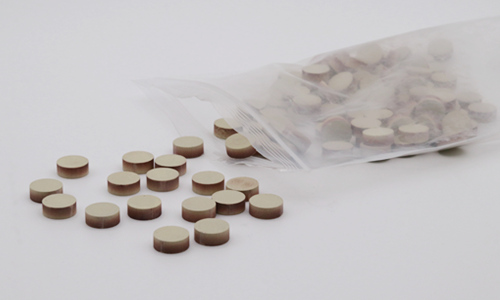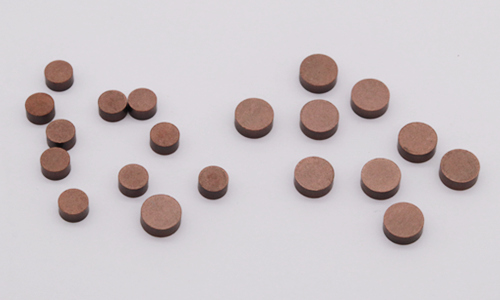Case of diamond tools for polishing sapphire dome
Sapphire has excellent physical, chemical and optical properties. It is widely used in many high-tech fields as optical components, substrate materials, laser and luminescence materials and sensors. Sapphire wafers have extremely high surface quality requirements when used in these fields. Chemical mechanical polishing is the most commonly used method for surface processing. Its advantages are little or no surface and subsurface damage, the ability to eliminate surface defects, high removal rate, high efficiency and low cost.
Sapphire is known for its wide range of transmission, from ultraviolet (UV) to infrared (IR) spectrum. High refractive index, extremely high hardness, and excellent heat and chemical resistance make it an ideal choice for demanding applications, including high-pressure windows, lenses and substrates in aerospace, defense and industrial systems. Its robustness enables it to withstand harsh environmental conditions, making sapphire the first choice for durable and reliable optical components in various advanced technology applications.
The main component of sapphire is aluminum oxide (Al₂O₃). It belongs to the trigonal crystal system, and the crystal morphology is often cylindrical, short columnar, plate-like, etc., and the geometry is mostly granular or dense blocky. Transparent to translucent, glassy luster. It has a hexagonal structure. Sapphire has a melting point of 2040°C, a Mohs hardness of 9, and a refractive index of 1.76 to 1.78. If free of impurities, sapphire makes an excellent optical window material because it is clear and transparent throughout the visible light range, even as far as ultraviolet and infrared. With such characteristics, it is no wonder that sapphire has been a precious gemstone throughout history. These same characteristics also make sapphire very attractive for non-gemstone applications, and today’s most advanced artificial synthetic crystal growth and processing technology has led to a growing demand for this material.
Chemical properties of Sapphire
Sapphire crystals are very stable in chemical properties. They are generally insoluble in water and are not corroded by acids and alkalis. They can only be corroded by hydrofluoric acid, phosphoric acid and molten potassium hydroxide at higher temperatures (300°C).
Physical properties
Sapphire crystals are very hard, with a Mohs hardness of 9, second only to the hardest diamond. It has good light transmittance, thermal conductivity and electrical insulation, good mechanical properties, and is wear-resistant and wind-resistant. The melting point of sapphire crystal is 2050℃, the boiling point is 3500℃, and the maximum operating temperature can reach 1900℃.
Sapphire’s toughness, durability, transparency and wide spectral range are the reasons why it can be widely used in windows or lenses. Compared with other materials, sapphire windows or lenses can withstand higher temperatures and zero degradation. Such as: cameras, detectors, outer space telescopes, blast furnaces (can withstand extremely high temperatures), centrifuges, anti-laser damage, underwater unmanned vehicles (resistant to high pressure), etc.
Applictions of diamond pellets:
Diamond pellets are used for rough and fine grinding of optical spherical lenses and prisms.
Diamond pellets/fine grinding sheets are mainly used for fine processing after rough processing of optical glass. Fine grit diamond pellets generally use metal binders, and super fine grinding sheets use resin bonds. According to the physical properties of optical glass, using fine grit diamond pellets with different types of binders will obtain better processing results. Fine grinding sheets are used in conjunction with coolants to maintain the self-sharpening of processing.

Currently commonly used specifications include:φ6*4, φ8*3.5, φ10*5, φ16*3 (0.5C, 1C, 2C, 3C, 4C, 5C, 6C, 7C, 8C, 9C), etc. Abrasive models include W20, W14, W10, W7 and other models.

Selection of fine grit diamond pellets
The following points should be noted when selecting diamond fine grinding sheets.
1. Selection of particle size
Since the fine grinding process is between the rough grinding and polishing processes, it plays a key role in connecting the previous and the next. Therefore, it is particularly important to correctly select fine grinding discs with appropriate diamond particle sizes. The principle of selection is that the fine grinding discs used must be able to effectively remove the rough grinding traces left by the previous process, and ensure that the fine scratches produced by this process are completely eliminated in the subsequent polishing. For the optical elements used in ordinary telescopes, generally only one process is required to use metal-based 1200# or 1500# (the surface roughness Ra value of the optical element reaches 0.16~0.32μm), and then it can be turned to polishing. For instruments such as microscopes and cameras that have higher requirements for optical elements, two fine grinding processes can be used. First, use 1000# and 1200# metal-based fine grinding for one fine grinding, and then use 1500# or 1800# resin-based pellets for the second fine grinding (the surface roughness Ra of the optical element reaches less than 0.10μm).
If the particle size of the fine grinding disc is too coarse, the daisy-shaped marks left by the rough grinding can be clearly seen on the surface of the optical element after fine grinding, or bright spots are left on the surface of the optical element after polishing.
2. Selection of the size of the fine grinding disc:
The size and trial range of the fine grinding disc are determined mainly from the curvature radius of the processed optical element and the surface area of the cast iron mold for pasting the pills. The details are shown in the following table:
| The radius of curvature of the optical element(mm) | 10-20 | 20-30 | 30-50 |
| Surface area of the finishing disk(cm²) | 6-25 | 25-50 | 50-100 |
| Size of fine grit diamond pellets:
Diameter*thickness(mm) |
Ф4*3 | Ф6*3, Ф8*3 | Ф8*3, AAФ10*3(4), Ф12*3(4) |
Recently Moresuperhard have one customer who inquired about diamond pellets for sapphire optical parts, lets see it together:
Customer requires:
“We process sapphire optical parts, so we are interested in your product for sapphire grinding and polishing. Right now we are looking for diamond pellets for sapphire dome fine grinding and polishing. We need not metal bonded pellets like resin bonded or ceramic bonded.”
| Work-piece | sapphire dome |
| Grinding | Vitrified diamond pellets |
| Dimensions | D5* 4mm, D15* 5mm |
| Particle size | 30/40µm |
What is PU polishing pad?
PU (Polyurethane) polishing pad is a polishing pad with high durability. After mixing polyurethane prepolymer, hardener, and foaming agent, it is poured into a shaping container to form a block, and then processed into a final sheet polishing pad through a slicing machine.
Application of polishing pad:
The lenses from the previous grinding process undergo final polishing to make the lenses transparent. The accuracy of the lens curvature is further improved to approximately 0.0003 to 0.001 mm depending on the pad polishing tool and polishing slurry used.
Moresuperhard LP series polishing pad for polishing precision optical components(lens, prism ), precision ceramics, wafers, metals, optical windows, optical glass, filters, optical crystals, etc…
The abrasive of the optic polishing pad has three types of filler:
–Zirconium Oxide polishing pad
–Cerium Oxide polishing pad
–Diamond polishing pad
Case of polishing pad for polishing sapphire optical parts
| Polishing | PU polishing pad |
| Type | HR383 |
| Maximum hardness | Shao A88 |
| Dimensions | 300mmx2.0 thickness with adhesive and 10x10mm grooved |
—EDITOR: Doris Hu, Anna Wang
—POST: Doris Hu










